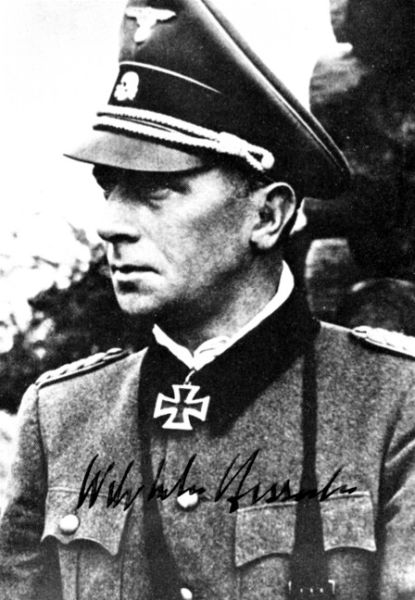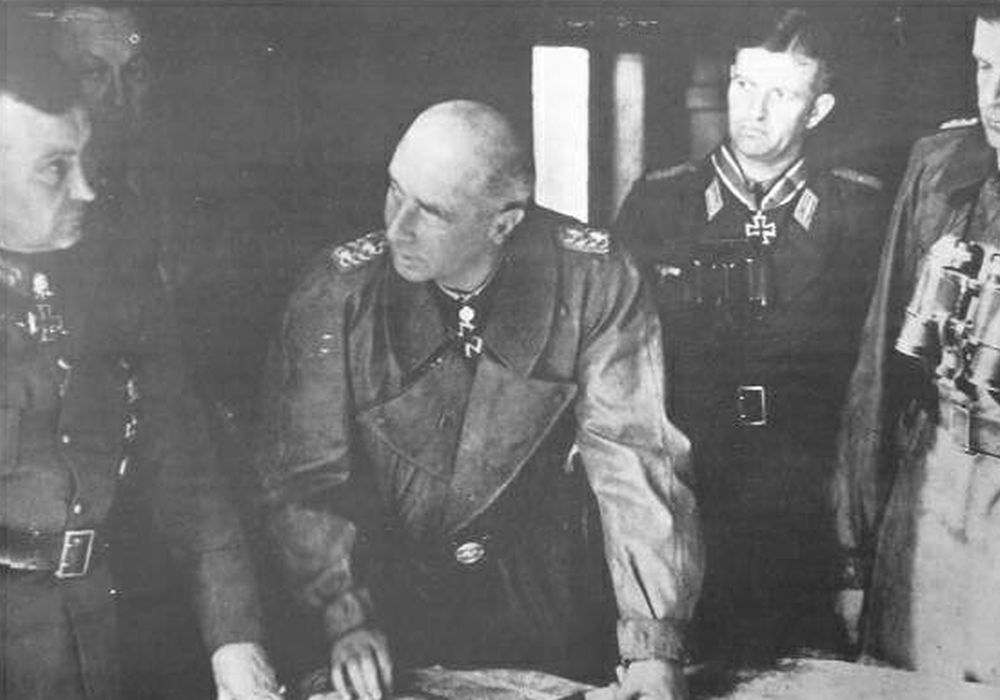Bittrich, Wilhelm "Willi" (Waffen SS)
- Date of birth:
- February 26th, 1894 (Wernigerode, German Empire)
- Date of death:
- April 19th, 1979 (Wolfratshausen, Germany)
- Service number:
- SS-Nr:. 39.177 // NSDAP-Nr.: 829.700
- Nationality:
- German
Biography
Was recommended to receive the Eichenlaub mit Schwertern to the Ritterkreuz. Up till now no formal confirmation of any awaridng has ever been found.
00.00.1914: Freiwilliger, Jägerbataillon Nr. 7
15.09.1915: promoted to Leutnant
00.00.1916: pilot, Jagdstaffel 37
00.00.1917: Fliegerabteilung der Artillerie 226
00.00.1919: Freikorps Hülsen
00.00.1925: Luftwaffe, Soviet Union
00.00.1932: awarded the SA/SS Fliegerabzeichen
01.07.1932: SS-Anwärter
15.07.1932: SS-Mann
10.09.1932: SS-Oberscharführer
31.10.1932: SS-Sturmführer
01.12.1932: entered the NSDAP
00.00.1933: Chef, 2. Kompanie, I. Bataillon, SS-Standarte 'Germania', SS-VT
12.04.1934: SS-Obersturmführer
17.06.1934: SS-Hautpsturmführer
01.10.1936: SS-Sturmbannführer
30.01.1938: SS-Obersturmbannführer
00.00.1938: Führer, II. Bataillon, SS-Standarte 'Deutschland'
06.06.1939: SS-Standartenführer
00.09.1939: Stab, Leibstandarte-SS Adolf Hitler - campaign in Poland
01.02.1940: SS-Führungshauptamt
01.09.1940: SS-Oberführer, Kdr, SS-Standarte 'Deutschland'
Do you have more information about this person? Inform us!
- Period:
- First World War (1914-1918)
- Period:
- First World War (1914-1918)
- Period:
- First World War (1914-1918)
- Period:
- First World War (1914-1918)
- Awarded on:
- 1918
- Period:
- First World War (1914-1918)
- Awarded on:
- 1934
- Period:
- Second World War (1939-1945)
- Rank:
- SS-Oberführer (Brigade General)
- Unit:
- Stab, Leibstandarte-SS Adolf Hitler, 17. Infanterie-Division
- Awarded on:
- September 25th, 1939
- Awarded for:
- Operation Fall Weiss
- Period:
- Second World War (1939-1945)
- Rank:
- SS-Oberführer (Brigade General)
- Unit:
- Kdr, SS-Regiment "Deutschland", SS-Verfügungsdivision
- Awarded on:
- June 7th, 1940
- Awarded for:
- Operation Fall Gelb
- Period:
- Second World War (1939-1945)
- Rank:
- SS-Oberführer (Brigade General)
- Unit:
- Kdr, SS-Panzergrenadier-Regiment “Deutschland”, SS-Division “Reich”, XXXX. Panzer-Korps, Panzergruppe 4, Heeresgruppe Mitte
- Awarded on:
- December 14th, 1941
- Awarded for:
- Operation Barbarossa
“SS-Brigadeführer Bittrich was awarded the Iron Cross First & Second Class during the Polish campaign. During the operations in Russia he led SS-Regiment ‘Deutschland’ until the divisional commander was wounded on the 14.10.1941.
He has led his Regiment with personal boldness, rigour and prudence, achieving great successes in this role. During the battle for Yelnya he and his Regiment captured Hill 125.6 on the 22.07.1941 and defended this place against non-stop attacks by a numerically and materially superior enemy until being relieved on the 08.08.1941. After this he particularly distinguished himself on the 13.10.1941:
The SS-Regiment ‘Deutschland’, initially reinforced by a Panzer-Abteilung of the 10. Panzer-Division, had the mission of reaching the Moscow defensive position by advancing along the old post road Gshatsk—Moshaisk as the left column of the SS-Division ‘Reich’. Meanwhile the reinforced SS-Regiment ‘Der Führer’ was to carry out the same mission along the highway as the right column of the Division. The Regiment dispatched reconnaissance against its assigned position, which was reported to be strongly fortified and occupied.
At 13:00 the commander of SS-Regiment ‘Deutschland’ was able to confirm via reconnaissance that there was a weakly held point at the railroad track between the highway and the post road. He realized that pausing the advance here would put the enemy on alert and enable them to reinforce their defenses at this position. The regimental commander thus decided to penetrate into the position under the protection of a few Panzers as well as a Batterie that had been swiftly brought into position. The Regiment had been on the attack constantly for 7 days, had sustained heavy casualties and had gone without field kitchens for 4 days (implying no warm meals) due to the bad road conditions.
Even with all this the penetration succeeded; the enemy was totally surprised. A continuous tank ditch with a wire obstacle was quickly overcome. By nightfall a penetration measuring 500 metres deep and 1 km wide had been achieved. During the night Bittrich succeeded in expanding the penetration to a width of 3 km by daybreak together with the by now alerted neighbouring Regiment. On the 14.10.1941 both Regiments succeeded in expanding this penetration following hard combat amongst the 3 km deep, strongly fortified position. The strength of the position and the decisive importance of Bittrich’s swift action is made all the more clear by both the large amount of captured materiel and the attached sketch. The following was captured during the breakthrough of the Moscow defensive position:
21 artillery pieces
14 anti-tank guns
92 heavy machine-guns
10 heavy mortars
14 tanks
65 flamethrowers
2 trucks
1 car
1 armoured car
1 engineer equipment depot
859 prisoners.
The independent resolve of the commander of SS-Regiment ‘Deutschland’, SS-Brigadeführer Bittrich, was the main force responsible for achieving this breakthrough within 24 hours and the consequent swift opening of the highway. The swift success made it impossible for the enemy to seal off the breakthrough position in the following days with their reinforcements. On the 18.10.1941 Moshaisk was occupied by the SS-Division ‘Reich’. On the following day, together with the 10. Panzer-Division, it managed to occupy a line between the crossroads 5 km south of Moshaisk and the eastern edge of Moshaisk itself. This was used as a jump-off point from which to continue the attack against Moscow.”
715th Award.
Submitted on December 3rd 1941 as Kommandeur - based on a recommendation dated 24.10.1941 and signed by Div. Kdr. Paul Hausser
- Period:
- Second World War (1939-1945)
- Awarded on:
- 1942
- Period:
- Second World War (1939-1945)
- Rank:
- SS-Brigadeführer / Generalmajor der Waffen-SS (Brigadier)
- Unit:
- Kdr, 8. SS-Kavallerie-Division "Florian Geyer", 9. Armee, 2. Panzer-Armee, Heeresgruppe Mitte
- Awarded on:
- March 6th, 1943
Award 325/1
- Period:
- Second World War (1939-1945)
- Rank:
- SS-Obergruppenführer / General der Waffen-SS (General)
- Unit:
- Kommandierender General, II. SS-Panzer-Korps, 7. Armee, Heeresgruppe B
- Awarded on:
- August 28th, 1944
“The Korps commanded by SS-Obergruppenführer Bittrich achieved outstanding defensive successes along the Invasion front. During July the Korps sealed off a major enemy penetration and held this position against powerful attacks. After the enemy had undertaken a regrouping they once again commenced a breakthrough attempt with overwhelming tank forces. But, through a bold attack, SS-Obergruppenführer Bittrich threw back and sealed off this attempt in a display of great devotion to duty. - Later on Bittrich’s Korps held its sector in the encirclement area against all enemy breakthrough attempts and then broke out of the encirclement ring under the prudent and brave leadership of SS-Obergruppenführer Bittrich.”
563rd Award.
Submitted on August 26th 1944 as Kommandierender General.
- Period:
- Second World War (1939-1945)
- Rank:
- SS-Obergruppenführer / General der Waffen-SS (General)
- Unit:
- Kommandierender General, II. SS-Panzer-Korps, 7. Armee, Heeresgruppe B
- Awarded on:
- September 27th, 1944
Sources
- Photo 1: Willi Schumacher Collection
- - FEDERL, CH., Die Ritterkreuzträger der Deutschen Panzerdivisionen 1939-1945, VDM Heinz Nickel, Zweibrücken, 2000.
- FELLGIEBEL, W.P., Elite of theThird Reich, Helion & Company Limited, Solihull, 2003.
- PATZWALL, K. & SCHERZER, V., Das Deutsche Kreuz 1941-1945, Band II, Verlag Klaus D. Patzwall, Norderstedt, 2001.
- SCHNEIDER, J.W., Their Honor Was Loyalty!, Bender (R.James) Publishing, 1993.
- Die Ordensträger der Deutschen Wehrmacht (CD), VMD-Verlag GmbH, Osnabrück, 2002
- Kwasny A., Kwasny G., Die Eichenlaubträger 1940-1945 (CD), Deutsches Wehrkundearchiv, Lage-Waddenhausen, 2001























